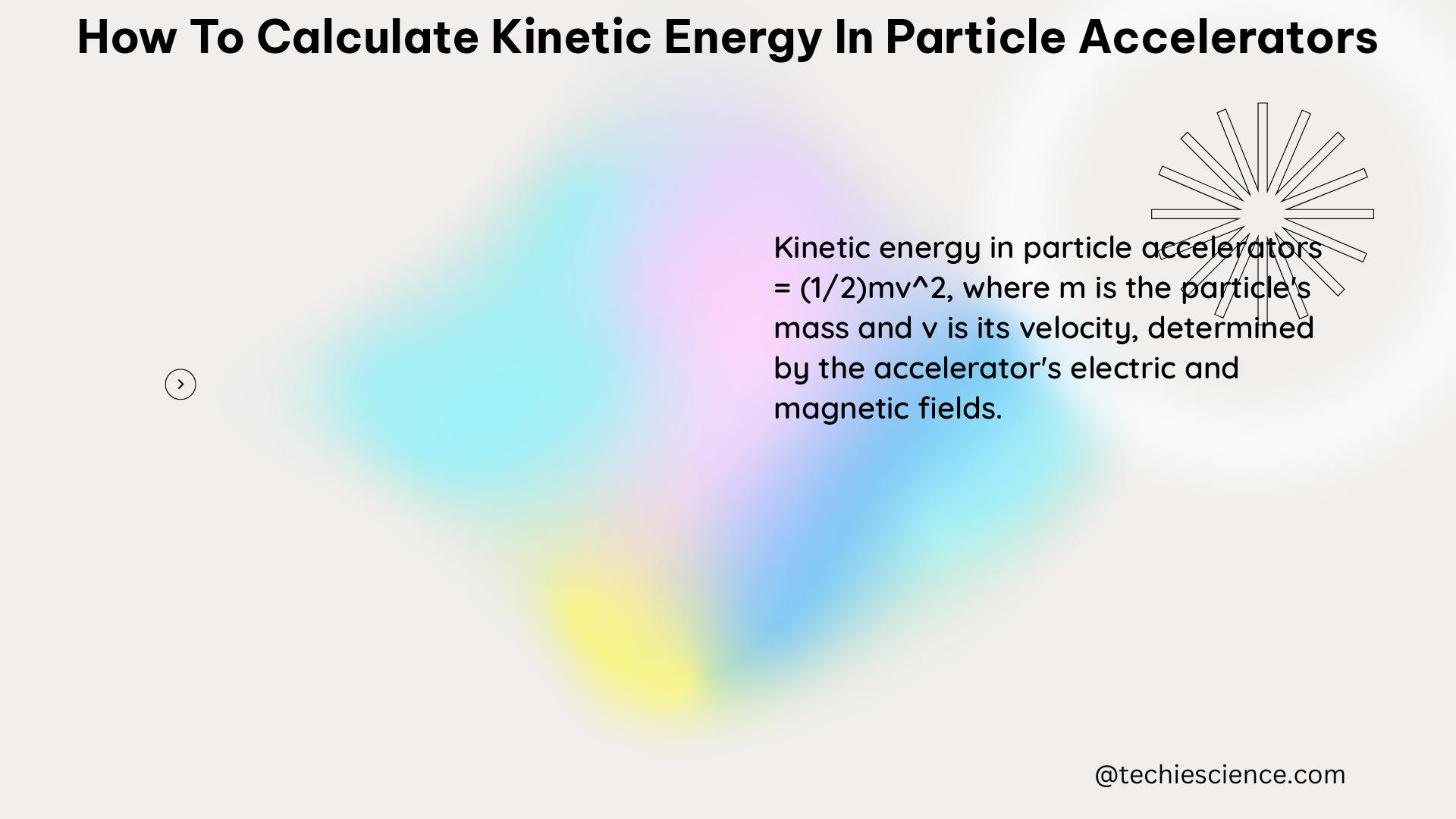Calculating the kinetic energy of particles in particle accelerators is a crucial aspect of understanding and optimizing the performance of these powerful scientific instruments. In this comprehensive guide, we will delve into the detailed steps and formulas required to accurately determine the kinetic energy of particles in particle accelerators.
Understanding Relativistic Kinetic Energy
The formula for relativistic kinetic energy is given by:
KErel = γmc² - mc²
where:
– KErel is the relativistic kinetic energy of the particle
– m is the rest mass of the particle
– c is the speed of light
– γ is the Lorentz factor, which is calculated as:
γ = 1 / √(1 - v²/c²)
Here, v is the velocity of the particle.
Calculating Kinetic Energy Step-by-Step

To calculate the kinetic energy of a particle in a particle accelerator, follow these steps:
- Identify the Known Parameters:
- Particle rest mass (
m) - Particle velocity (
v) -
Speed of light (
c) -
Calculate the Lorentz Factor (
γ):
γ = 1 / √(1 - v²/c²) -
Calculate the Relativistic Kinetic Energy (
KErel):
KErel = γmc² - mc² -
Convert the Kinetic Energy to the Desired Unit:
- The kinetic energy can be expressed in various units, such as electronvolts (eV), kiloelectronvolts (keV), or megaelectronvolts (MeV).
- To convert the kinetic energy to the desired unit, multiply the result by the appropriate conversion factor.
Let’s illustrate this process with an example:
Example: Calculating the Kinetic Energy of an Electron
Suppose we have an electron with a velocity of v = 0.990c, where c is the speed of light.
- Identify the Known Parameters:
- Electron rest mass (
m) = 9.11 × 10^-31 kg - Electron velocity (
v) = 0.990c -
Speed of light (
c) = 3.00 × 10^8 m/s -
Calculate the Lorentz Factor (
γ):
γ = 1 / √(1 - v²/c²)
γ = 1 / √(1 - (0.990c)²/c²)
γ ≈ 10.92 -
Calculate the Relativistic Kinetic Energy (
KErel):
KErel = γmc² - mc²
KErel = (10.92 - 1)(9.11 × 10^-31 kg)(3.00 × 10^8 m/s)²
KErel ≈ 528.5 keV
Therefore, the kinetic energy of the electron is approximately 528.5 keV.
Comparing Relativistic and Classical Kinetic Energy
It is important to note that the relativistic kinetic energy is always greater than the classical kinetic energy, especially for particles moving at velocities close to the speed of light.
The classical kinetic energy formula is given by:
KEclas = 1/2 mv²
Applying this formula to the same example, we get:
KEclas = 1/2 (9.11 × 10^-31 kg)(0.990)(3.00 × 10^8 m/s)²
KEclas ≈ 294.5 keV
As you can see, the relativistic kinetic energy (528.5 keV) is significantly higher than the classical kinetic energy (294.5 keV) for this high-velocity electron.
Advanced Considerations
-
Particle Beam Energy Spread: In particle accelerators, the beam of particles often has a distribution of energies, known as the energy spread. Calculating the energy spread is crucial for understanding the performance and optimization of the accelerator.
-
Beam Emittance: Emittance is a measure of the phase-space volume occupied by the particle beam. It is an important parameter in the design and operation of particle accelerators, as it affects the beam quality and the ability to focus the beam.
-
Synchrotron Radiation: Charged particles undergoing acceleration in a circular particle accelerator emit electromagnetic radiation, known as synchrotron radiation. The energy lost due to synchrotron radiation must be accounted for in the kinetic energy calculations.
-
Beam Dynamics: The dynamics of particle beams in accelerators, including the effects of electromagnetic fields, space charge, and other forces, play a crucial role in determining the kinetic energy and overall performance of the accelerator.
-
Numerical Simulations: Advanced numerical simulations, such as particle-in-cell (PIC) methods, are often employed to model the complex dynamics of particle beams in accelerators and accurately predict their kinetic energy and other important parameters.
Conclusion
Calculating the kinetic energy of particles in particle accelerators is a fundamental task in the field of accelerator physics. By understanding the relativistic kinetic energy formula and the associated concepts, you can accurately determine the energy of particles in these powerful scientific instruments. This knowledge is essential for the design, optimization, and operation of particle accelerators, which are crucial tools in various fields of science and technology.
References
- The Science and Technology of Particle Accelerators, Second Edition, edited by A. Chao, J. Chauveau, and C. Pellegrini. CRC Press, 2016.
- Introduction to Particle Physics, Second Edition, by David J. Griffiths. Wiley, 2018.
- Physics for Scientists and Engineers, by Raymond A. Serway and John W. Jewett. Cengage Learning, 2018.
- Particle Accelerator Physics, by Helmut Wiedemann. Springer, 2015.
- Accelerator Physics, by S.Y. Lee. World Scientific, 2004.

The lambdageeks.com Core SME Team is a group of experienced subject matter experts from diverse scientific and technical fields including Physics, Chemistry, Technology,Electronics & Electrical Engineering, Automotive, Mechanical Engineering. Our team collaborates to create high-quality, well-researched articles on a wide range of science and technology topics for the lambdageeks.com website.
All Our Senior SME are having more than 7 Years of experience in the respective fields . They are either Working Industry Professionals or assocaited With different Universities. Refer Our Authors Page to get to know About our Core SMEs.